Learninsta presents the core concepts of Biology with high-quality research papers and topical review articles.
Fungi Definition – Types, Characteristics, Classification and its Types
World War II and Penicillin
History Speaks on Fungi
Sir Alexander Fleming
Discovery of Penicillin in the year 1928 is a serendipity in the world of medicine. The History of World War II recorded the use of Penicillin in the form of yellow powder to save lives of soldiers. For this discovery – The wonderful antibiotic he shared Nobel Prize in Medicine in the year 1945 along with Ernest Boris chain and Sir Howard Walter Florey.
Milestones in Mycology
1729 – P.A. Micheli conducted spore culture experiments
1767 – Fontana proved that Fungi could cause disease in plants
1873 – C.H. Blackley proved fungi could cause allergy in Human beings
1904 – A.F.Blakeslee reported heterothallism in fungi
1952 – Pontecorvo and Roper reported Parasexual cycle
The word ‘fungus’ is derived from Latin meaning ‘mushroom’. Fungi are ubiquitous, eukaryotic, achlorophyllous heterotrophic organisms. They exist in unicellular or multicellular forms. The study of fungi is called mycology. (Gr. mykes – mushroom: logos – study). P.A. Micheli is considered as founder of Mycology. Few renowned mycologists include Arthur H.R. Buller, John Webster, D.L.Hawksworth, G.C.Ainsworth, B.B.Mundkur, K.C.Mehta, C.V. Subramanian and T.S. Sadasivan.
General Characteristic Features
Majority of fungi are made up of thin, filamentous branched structures called hyphae. A number of hyphae get interwoven to form mycelium. The cell wall of fungi is made up of a polysaccharide called chitin (polymer of N-acetyl glucosamine) and fungal cellulose.
The fungal mycelium is categorised into two types based on the presence or absence of septa (Figure 1.18). In lower fungi the hypha is aseptate, multinucleate and is known as coenocytic mycelium (Example: Albugo). In higher fungi a septum is present between the cells of the hyphae. Example: Fusarium.
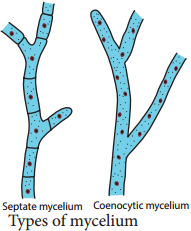
The mycelium is organised into loosely or compactly interwoven fungal tissues called plectenchyma. It is further divided into two types prosenchyma and pseudoparenchyma. In the former type the hyphae are arranged loosely but parallel to one another. In the latter hyphae are compactly arranged and loose their identity.
In holocarpic forms the entire thallus is converted into reproductive structure whereas in Eucarpic some regions of the thallus are involved in the reproduction other regions remain vegetative. Fungi reproduce both by asexual and sexual methods. The asexual phase is called Anamorph and the sexual phase is called Teleomorph. Fungi having both phases are called Holomorph.
General sexual reproduction in fungi includes three steps:-
- Fusion of two protoplasts (plasmogamy)
- Fusion of nuclei (karyogamy) and
- Production of haploid spores through meiosis. Methods of reproduction in fungi is given in Figure 1.19.
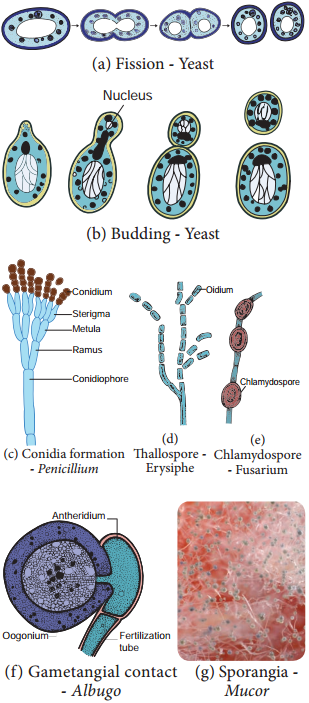
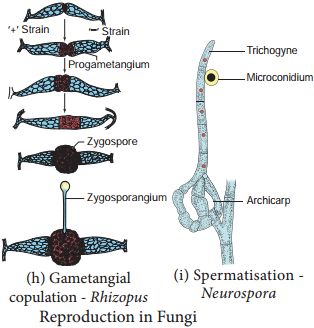
Methods of Reproduction in Fungi
Asexual Reproduction
1. Zoospores:
They are flagellate structures produced in zoosporangia (Example: Chytrids).
2. Conidia:
The spores produced on condiophores (Example: Aspergillus, Penicillium).
3. Oidia/Thallospores/Arthrospores:
The hypha divided and developed in to spores called oidia (Example: Erysiphe).
4. Fission:
The vegetative cell divides into 2 daughter cells. (Example: Schizosaccharomyces-yeast).
5. Budding:
A small outgrowth is developed on parent cell, which gets detached and becomes independent. (Example: Saccharomycesyeast)
6. Chlamydospore:
Thick walled resting spores are called chlamydospores (Example: Fusarium).
Sexual Reproduction
1. Planogametic Copulation:
Fusion of motile gamete is called planogametic copulation.
a. Isogamy:
Fusion of morphologically and physiologicall similar gametes. (Example: Synchytrium).
b. Anisogamy:
Fusion of morphologically or physiologically dissimilar gametes (Example: Allomyces).
c. Oogamy:
Fusion of both morphologically and physiologically dissimilar gametes. (Example: Monoblepharis).
2. Gametangial Contact:
During sexual reproduction a contact is established between antheridium and Oogonium (Example: Albugo).
3. Gametangial Copulation:
Fusion of gametangia to form zygospore (Example: Mucor, Rhizopus).
4. Spermatization:
In this method a uninucleate pycniospore/microconidium is transferred to receptive hyphal cell (Example: Puccinia, Neurospora)
5. Somatogamy:
Fusion of two somatic cells of the hyphae (Example: Agaricus)
Classification of Fungi
Many mycologists have attempted to classify fungi based on vegetative and reproductive characters. Traditional classifications categorise fungi into 4 classes – Phycomycetes, Ascomycetes, Basidiomycetes and Deuteromycetes. Among these ‘Phycomycetes’ include fungal species of Oomycetes, Chytridiomycetes and Zygomycetes which are considered as lower fungi indicating algal origin of fungi.
Constantine J. Alexopoulos and Charles W. Mims in the year 1979 proposed the classification of fungi in the book entitled ‘Introductory Mycology’. They classified fungi into three divisions namely Gymnomycota, Mastigomycota and Amastigomycota. There are 8 subdivisions, 11 classes, 1 form class and 3 form subclasses in the classification proposed by them.
The salient features of some of the classes – Oomycetes, Zygomycetes, Ascomycetes, Basidiomycetes and Form class Deuteromycetes are discussed below.
Oomycetes
Coenocytic mycelium is present. The cell wall is made up of Glucan and Cellulose. Zoospore with one whiplash and one tinsel flagellum is present. Sexual reproduction is oogamous. Example: Albugo.
Zygomycetes
- Most of the species are saprophytic and live on decaying plant and animal matter in the soil. Some lead parasitic life (Example: Entomophthora on housefly).
- Bread mold fungi (Example: Mucor, Rhizopus) and coprophilous fungi (Fungi growing on dung Example: Pilobolus) belong to this group (Figure 1.20).

- The mycelium is branched and coenocytic.
- Asexual reproduction by means of spores produced in sporangia.
- Sexual reproduction is by the fusion of the gametangia which results in thick walled zygospore. It remains dormant for long periods.
- The zygospore undergoes meiosis and produce spores.
Ascomycetes
- Ascomycetes include a wide range of fungi such as yeasts, powdery mildews, cup fungi, morels and so on (Figure 1.21).
- Although majority of the species live in terrestrial environment, some live in aquatic environments both fresh water and marine.
- The mycelium is well developed, branched with simple septum.
- Majority of them are saprophytes but few parasites are also known (Powdery mildew – Erysiphe).
- Asexual reproduction takes place by fission, budding, oidia, conidia, and chlamydospore.
- Sexual reproduction takes place by the fusion of two compatible nuclei.
- Plasmogamy is not immediately followed by karyogamy, instead a dikaryotic condition is prolonged for several generations.
- A special hyphae called ascogenous hyphae is formed.
- A crozier is formed when the tip of the ascogenous hyphae recurves forming a hooked cell. The two nuclei in the penultimate cell of the hypha fuse to form a diploid nucleus. This cell forms young ascus.
- The diploid nucleus undergo meiotic division to produce four haploid nuclei, which further divide mitotically to form eight nuclei. The nucleus gets organised into 8 ascospores.
- The ascospores are found inside a bag like structure called ascus. Due to the presence of ascus, this group is popularly called “Sac fungi”.
- Asci gets surrounded by sterile hyphae forming fruit body called ascocarp.
- There are 4 types of ascocarps namely Cleistothecium (Completely closed), Perithecium (Flask shaped with ostiole), Apothecium (Cup shaped, open type) and Pseudothecium.
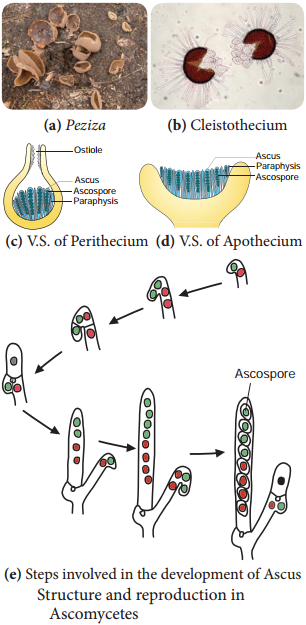
Basidiomycetes
Basidiomycetes include puff balls, toad stools, Bird’s nest fungi, Bracket fungi, stink horns, rusts and smuts (Figure 1.22).
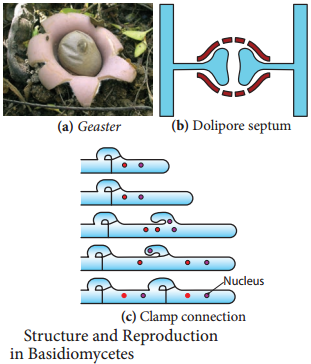
- The members are terrestrial and lead a saprophytic and parasitic mode of life.
- The mycelium is well developed, septate with dolipore septum (bracket like). Three types of mycelium namely primary (Monokaryotic), secondary (Dikaryotic) and tertiary are found.
- Clamp connections are formed to maintain dikaryotic condition.
- Asexual reproduction is by means of conidia, oidia or budding.
- Sexual reproduction is present but sex organs are absent. Somatogamy or spermatisation results in plasmogamy.
- Karyogamy is delayed and dikaryotic phase is prolonged.
- Karyogamy takes place in basidium and it is immediately followed by meiotic division.
- The four nuclei thus formed are transformed into basidiospores which are borne on sterigmata outside the basidium (Exogenouz).
- The basidium is club shaped with four basidiospores, thus this group of fungi is popularly called “Club fungi”. The fruit body formed is called Basidiocarp.
Deuteromycetes or Fungi Imperfecti
The fungi belonging to this group lack sexual reproduction and are called imperfect fungi. A large number of species live as saprophytes in soil and many are plant and animal parasites. Asexual reproduction takes place by the production of conidia, chlamydospores, budding, oidia etc., Conidia are also produced in special structures called pycnidium, acervulus, sporodochium and synnemata (Figure 1.23). Parasexual cycle operates in this group of fungi. This brings genetic variation among the species.

Economic Importance
Fungi provide delicious and nutritious food called mushrooms. They recycle the minerals by decomposing the litter thus adding fertility to the soil. Dairy industry is based on a single celled fungus called yeast. They deteriorate the timber. Fungi cause food poisoning due the production of toxins. The Beneficial and harmful activities of fungi are discussed below:
Beneficial Activities
Food
Mushrooms like Lentinus edodes, Agaricus bisporus, Volvariella volvaceae are consumed for their high nutritive value. Yeasts provide vitamin B and Eremothecium ashbyii is a rich source of Vitamin B12.
Medicine
Fungi produce antibiotics which arrest the growth or destroy the bacteria. Some of the antibiotics produced by fungi include Penicillin (Penicillium notatum) Cephalosporins (Acremonium chrysogenum) Griseofulvin (Penicillium griseofulvum). Ergot alkaloids (Ergotamine) produced by Claviceps purpurea is used as vasoconstrictors.
Industries
Production of Organic Acid:
For the commercial production of organic acids fungi are employed in the Industries. Some of the organic acids and fungi which help in the production of organic acids are: citric acid and gluconic acid – Aspergillus niger, Itaconic acid – Aspergillus terreus, Kojic acid – Aspergillus oryzae.
Bakery and Brewery
Yeast(Saccharomyces cerevisiae) is used for fermentation of sugars to yield alcohol. Bakeries utilize yeast for the production of Bakery products like Bread, buns, rolls etc., Penicillium roquefortii and Penicillium camemberti were employed in cheese production.
Production of Enzymes
Aspergillus oryzae, Aspergillus niger were employed in the production of enzymes like amylase, protease, lactase etc. Rennet which helps in the coagulation of milk in cheese manufacturing is derived from Mucor spp.
Agriculture
Mycorrhiza forming fungi like Rhizoctonia, Phallus, Scleroderma helps in absorption of water and minerals. Fungi like Beauveria bassiana, Metarhizium anisopliae are used as Biopesticides to eradicate the pests of crops. Gibberellin, produced by a fungus Gibberella fujikuroi induce the plant growth and is used as growth promoter.
Harmful Activities
Fungi like Amanita phalloides, Amanita verna, Boletus satanus are highly poisonous due to the production of Toxins. These fungi are commonly referred as “Toad stools”.
Aspergillus, Rhizopus, Mucor and Penicilium are involved in spoilage of food materials. Aspergillus flavus infest dried foods and produce carcinogenic toxin called aflatoxin.
Patulin, ochratoxin A are some of the toxins produced by fungi.Fungi cause diseases in Human beings and plants (Table 1.11).
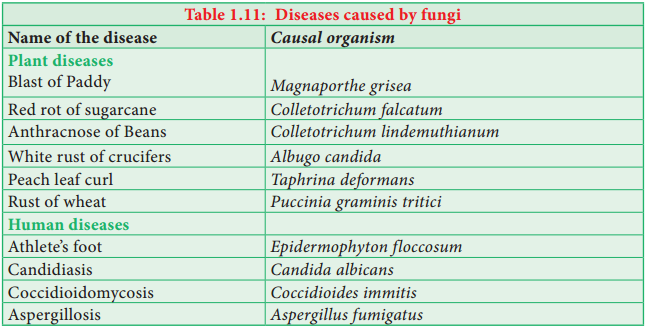
Activity 1.4
Get a button mushroom. Draw diagram of the fruit body. Take a thin longitudinal section passing through the gill and observe the section under a microscope. Record your observations.
Activity 1.5
Keep a slice of bread in a clean plastic tray or plate. Wet the surface with little water. Leave the setup for 3 or 4 days. Observe the mouldy growth on the surface of the bread. Using a needle remove some mycelium and place it on a slide and stain the mycelium using lactophenol cotton blue. Observe the mycelium and sporangium under the microscope and record your observation and identify the fungi and its group based on characteristic features.
Mycorrhizae
The symbiotic association between fungal mycelium and roots of plants is called as mycorrhizae. In this relationship fungi absorb nutrition from the root and in turn the hyphal network of mycorrhizae forming fungi helps the plant to absorb water and mineral nutrients from the soil (Figure 1.24). Mycorrhizae is classified into three types (Table 1.12)
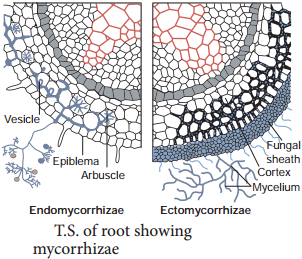
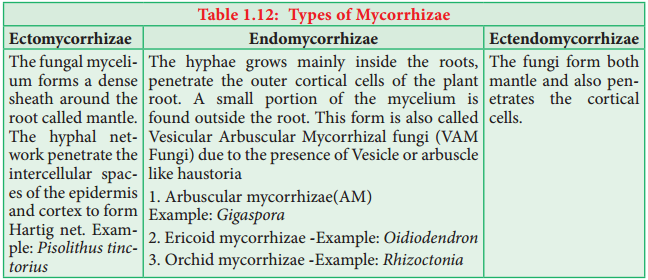
Importance of Mycorrhizae
- Helps to derive nutrition in Monotropa, a saprophytic angiosperm,
- Improves the availability of minerals and water to the plants.
- Provides drought resistance to the plants
- Protects roots of higher plants from the attack of plant pathogens
Lichens
The symbiotic association between algae and fungi is called lichens. The algal partner is called Phycobiont or Photobiont., and the fungal partner is called Mycobiont. Algae provide nutrition for fungal partner in turn fungi provide protection and also help to fix the thallus to the substratum through rhizinae.
Asexual reproduction takes place through fragmentation, Soredia and Isidia. Phycobionts reproduce by akinetes, hormogonia, aplanospore etc., Mycobionts undergo sexual reproduction and produce ascocarps.
Classification
- Based on the habitat lichens are classified into following types: Corticolous (on Bark) Lignicolous (on Wood) Saxicolous (on rocks) Terricolous (on ground) Marine (on siliceous rocks of sea) Fresh water (on siliceous rock of fresh water).
- On the basis of morphology of the thallus they are divided into Leprose (a distinct fungal layer is absent) Crustose-crust like; Foliose-leaf like; Fruticose- branched pendulous shrub like (Figure 1.25).

- The distribution of algal cells distinguishes lichens into two forms namely Homoiomerous (Algal cells evenly distributed in the thallus) and Heteromerous (a distinct layer of algae and fungi present).
- If the fungal partner of lichen belongs to ascomycetes, it is called Ascolichen and if it is basidiomycetes it is called Basidiolichen.
Lichens secrete organic acids like Oxalic acids which corrodes the rock surface and helps in weathering of rocks, thus acting as pioneers in Xerosere. Usnic acid produced from lichens show antibiotic properties. Lichens are sensitive to air pollutants especially to sulphur-di-oxide. Therefore, they are considered as pollution indicators.
The dye present in litmus paper used as acid base indicator in the laboratories is obtained from Roccella montagnei. Cladonia rangiferina (Reindeer mose) is used as food for animals living in Tundra regions.